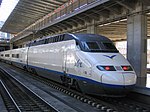AVE
 | |
 | |
| Main station(s) | Madrid Atocha, Barcelona Sants, Seville-Santa Justa, Zaragoza–Delicias |
|---|---|
| Other station(s) | Madrid Chamartín, Valencia-Joaquín Sorolla, Málaga-María Zambrano, Granada, Alicante Terminal, Valladolid-Campo Grande, A Coruña-San Cristóbal, Santiago de Compostela railway station, Ourense, Córdoba |
| Fleet size | 22 S-100[1] 16 S-102[2] 26 S-103[3] 20 S-106[4] 25 S-112[5] |
| Stations called at | 52 |
| Parent company | Renfe |
| Technical | |
| Track gauge | Standard (1435 mm) |
| Electrification | 25 kV AC (some sections on 3 kV DC network) |
| Length | 3,966 km (2,464 mi)[6] |
| Other | |
| Website | https://www.renfe.com |
Alta Velocidad Española (AVE)[a] is a high-speed rail service operated by Renfe, the Spanish State railway company.
The first AVE service was inaugurated in 1992, with the introduction of the first Spanish high-speed railway connecting the cities of Madrid, Córdoba and Seville.
In addition to Renfe's use of the Administrador de Infraestructuras Ferroviarias-managed rail infrastructure in Spain, Renfe offers two AVE services partially in France, connecting respectively Barcelona-Lyon and Madrid-Marseille.[7]
Alta Velocidad Española translates to "Spanish High Speed", but the initials are also a play on the word ave, meaning "bird". AVE trains operate at speeds of up to 300 km/h (186 mph).[8][9]
Services
[edit]As of 2024[update] Renfe offers the following AVE services:[10]
- Alicante–León via Albacete, Cuenca, Madrid Chamartín, Valladolid and Palencia.
- Alicante–Ourense via Albacete, Cuenca, Madrid Chamartín and Zamora.
- Barcelona–Granada via Tarragona, Lleida, Zaragoza, Ciudad Real, Puertollano, Córdoba and Antequera.
- Barcelona–Málaga via Tarragona, Lleida, Zaragoza, Ciudad Real, Córdoba, Puente Genil-Herrera, and Antequera.
- Barcelona–Seville via Tarragona, Lleida, Zaragoza, Ciudad Real, Puertollano and Córdoba (trains with selective stops are also scheduled).
- Burgos–Murcia via Valladolid, Segovia, Madrid-Chamartín, Elche and Orihuela.
- Gijón–Castellón via Oviedo, Mieres Del Camín, La Pola, León, Palencia, Valladolid, Segovia, Madrid-Chamartín, Cuenca, Valencia and Sagunto.
- Gijón–Vinaros, via Oviedo, Mieres Del Camín, La Pola, León, Palencia, Valladolid, Segovia, Madrid-Chamartín, Cuenca, Valencia, Sagunto, Castellón, Benicàssim, Oropesa del Mar and Benicarló (only in summertime).
- Huesca–Seville via Tardienta, Zaragoza, Calatayud, Guadalajara, Madrid-Puerta de Atocha and Córdoba
- Madrid–A Coruña via Zamora, Ourense and Santiago De Compostela.
- Madrid–Alicante via Cuenca, Albacete, and Villena (non stop trains and trains with selective stops are also scheduled).
- Madrid–Barcelona via Guadalajara, Calatayud, Zaragoza, Lleida, and Tarragona (non stop trains and trains with selective stops are also scheduled).
- Madrid–Castellón via Cuenca, Requena-Utiel and Valencia.
- Madrid–Figueres via Guadalajara, Calatayud, Zaragoza, Lleida, Tarragona, Barcelona and Girona (trains are scheduled with selective stops).
- Madrid–Gijón via Valladolid, Palencia, León and Oviedo.
- Madrid–Granada via Ciudad Real, Puertollano, Córdoba, Puente Genil-Herrera, Antequera and Loja (trains with selective stops are also scheduled).
- Madrid–Huesca via Guadalajara, Calatayud, Zaragoza, and Tardienta.
- Madrid–León via Segovia, Valladolid and Palencia.
- Madrid–Málaga via Ciudad Real, Puertollano, Córdoba, Puente Genil-Herrera, and Antequera (non stop trains and trains with selective stops are also scheduled).
- Madrid–Murcia via Elche and Orihuela (some trains are arriving to Alicante and then reversing towards Murcia).
- Madrid–Ourense via Zamora.
- Madrid–Seville via Ciudad Real, Puertollano, and Córdoba (non stop trains and trains with selective stops are also scheduled).
- Madrid–Valencia via Cuenca and Requena-Utiel (non stop trains are also scheduled).
- Madrid–Vigo via Zamora, Sanabria, A Gudiña, Ourense, Santiago De Compostela and Pontevedra.
- Valencia–Burgos via Requena-Utiel, Cuenca, Madrid Chamartín and Valladolid (trains with selective stops are also scheduled).
- Valencia–León via via Requena-Utiel, Cuenca, Madrid-Chamartín, Segovia, Valladolid and Palencia (trains with selective stops are also scheduled).
- Valencia–Seville via Cuenca, Ciudad Real, Puertollano, and Córdoba.
- International:[11]
- Barcelona–Lyon via Girona, Figueres, Perpignan, Narbonne, Montpellier, Nîmes, and Valence.
- Madrid–Marseille via Guadalajara, Zaragoza, Tarragona, Barcelona, Girona, Figueres, Perpignan, Narbonne, Béziers, Montpellier, Nîmes, Avignon and Aix-en-Provence.
The central hub of the AVE system is Madrid's Puerta de Atocha, except for the Madrid–Asturias, Madrid–Burgos, Madrid–Galicia, Madrid–Alicante and Madrid-Murcia lines, that terminate at Chamartín station.[12][13]
Trains
[edit]Currently, there are several series of high-speed trains that run the AVE service:
- S-100, manufactured by Alstom
- S-102, manufactured by Talgo and Bombardier
- S-103, manufactured by Siemens, marketed globally under the brand Siemens Velaro
- S-106, manufactured by Talgo, marketed globally as Talgo AVRIL.
- S-112, manufactured by Talgo and Bombardier
-
A Talgo 350 train (Renfe Class 102) at Madrid Atocha station.
-
AVE train Talgo 350 (Renfe Class 102)
-
Talgo 350 train (Renfe Class 102) at Lleida Pirineus station
-
AVE "Alstom" (Renfe Class 100) trainset at Córdoba.
-
A RENFE AVE S-103 (Siemens Velaro E) at Figueres Vilafant railway station in 2013.
-
AVE Talgo Avril train (Renfe Class 106).
Passenger usage
[edit]The still-growing network transported a record 32.4 million passengers in 2023.[14] Though the network length is extensive, it lags in ridership behind comparable high-speed rail systems in Japan, France, Germany, China, Taiwan, and Korea.
2000s
|
2006 | 2007 | 2008 | 2009 | ||||||
|---|---|---|---|---|---|---|---|---|---|---|
| 4.878 | 5.559 | 11.461 | 11.250 | |||||||
2010s
|
2010 | 2011 | 2012 | 2013 | 2014 | 2015 | 2016 | 2017 | 2018 | 2019 |
| 10.851 | 12.563 | 12.101 | 14.697 | 17.967 | 19.428 | 20.352 | 21.108 | 21.332 | 22.370 | |
2020s
|
2020 | 2021 | 2022 | 2023 | 2024 | 2025 | 2026 | 2027 | 2028 | 2029 |
| 7.603 | 12,282 | 23,562 | 31,784 |
Graphs are unavailable due to technical issues. There is more info on Phabricator and on MediaWiki.org. |
Rail infrastructure in Spain and Europe
[edit]- Rail transport in Spain
- High-speed rail in Spain
- High-speed rail in Europe
- Train categories in Europe
Notes
[edit]- ^ Spanish pronunciation:
References
[edit]- ^ "S-100". Renfe. Retrieved 18 June 2024.
- ^ "S-102/112". Renfe. Retrieved 18 June 2024.
- ^ "S-103". Renfe. Retrieved 18 June 2024.
- ^ "Renfe pone en circulación los S-106 con un incremento de 14.400 plazas para los servicios Avlo que circulan entre Madrid, Aragón, Cataluña, Comunitat Valenciana y Murcia" (in Spanish). Renfe. 26 April 2024. Retrieved 18 June 2024.
- ^ "Flota de trenes". Renfe. Retrieved 18 June 2024.
- ^ "Red de Alta Velocidad". ADIF. Retrieved 7 May 2023.
- ^ "Renfe empieza a operar en Francia con un AVE entre Barcelona y Lyon". rtve.es. 13 July 2023.
- ^ "Madrid — Barcelona at 310 km/h with ETCS Level 2". Railway Gazette International. London. 18 October 2011. Retrieved 9 November 2011.
- ^ "Velocidades máximas de los trenes y de las líneas" (maximum speeds of the trains and of the lines), last updated on 10 December 2022, accessed on 7 May 2023.
- ^ "Renfe". Renfe. Retrieved 7 May 2023.
- ^ "Renfe places AVE (high-speed) tickets on sale in France". Renfe. 21 June 2023. Retrieved 21 August 2023.
- ^ "Renfe reorganiza la oferta de los servicios AVE Madrid-Alicante tras el traslado de la cabecera de Puerta de Atocha a Chamartín Clara Campoamor" (in Spanish). Renfe. 19 August 2022. Retrieved 23 August 2022.
- ^ "El AVE Madrid-Murcia comenzará el servicio comercial el próximo 20 de diciembre". Renfe. 12 December 2022. Retrieved 20 December 2022.
- ^ "High-Speed Rail in Spain Sees Record Usage in 2023". ftnnews.com. 26 July 2024. Retrieved 24 September 2024.
- ^ "High Speed: Open access comes to Spain". Railway Gazette International. Retrieved 2024-10-24.
- ^ "Spain: high-speed rail passenger traffic 2022". Statista. Retrieved 2023-12-24.







